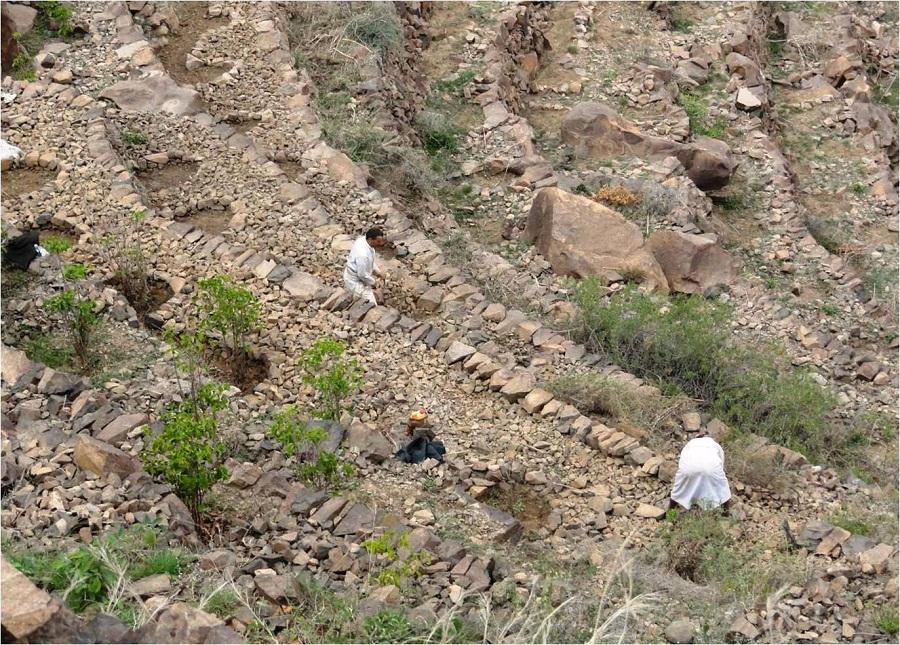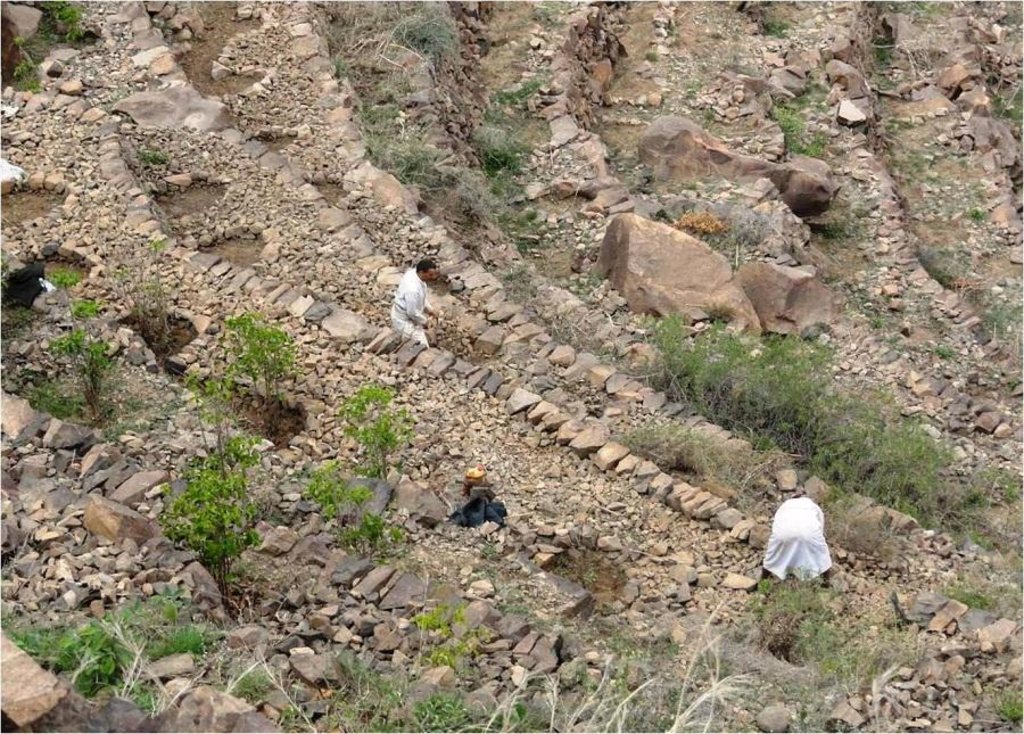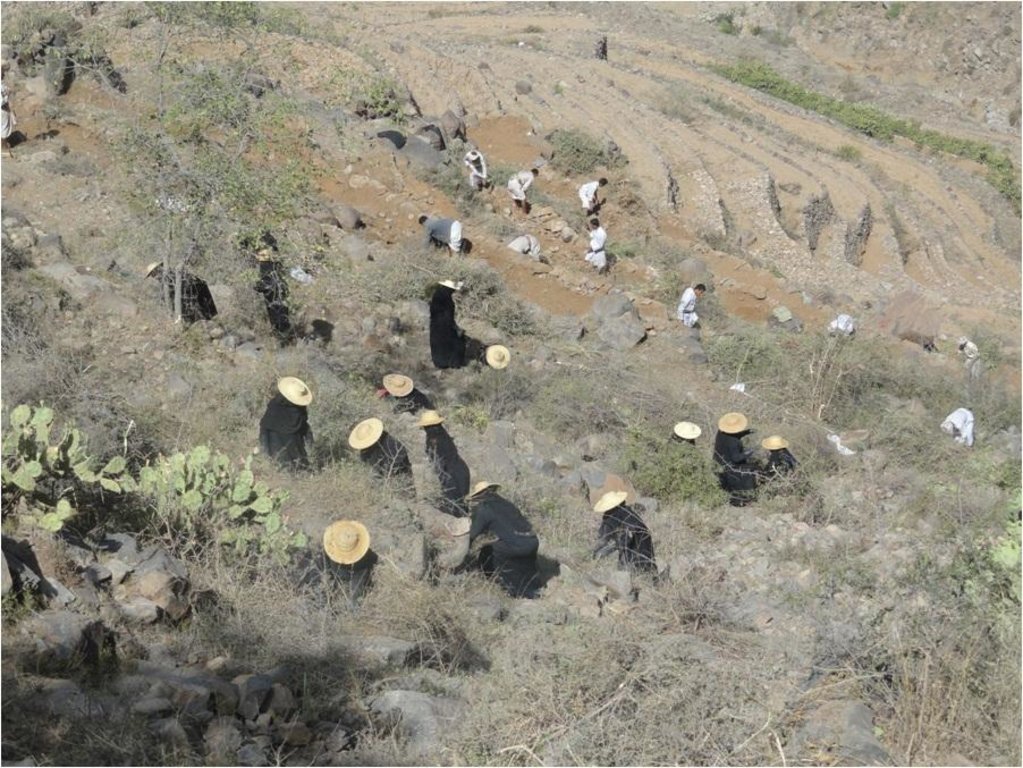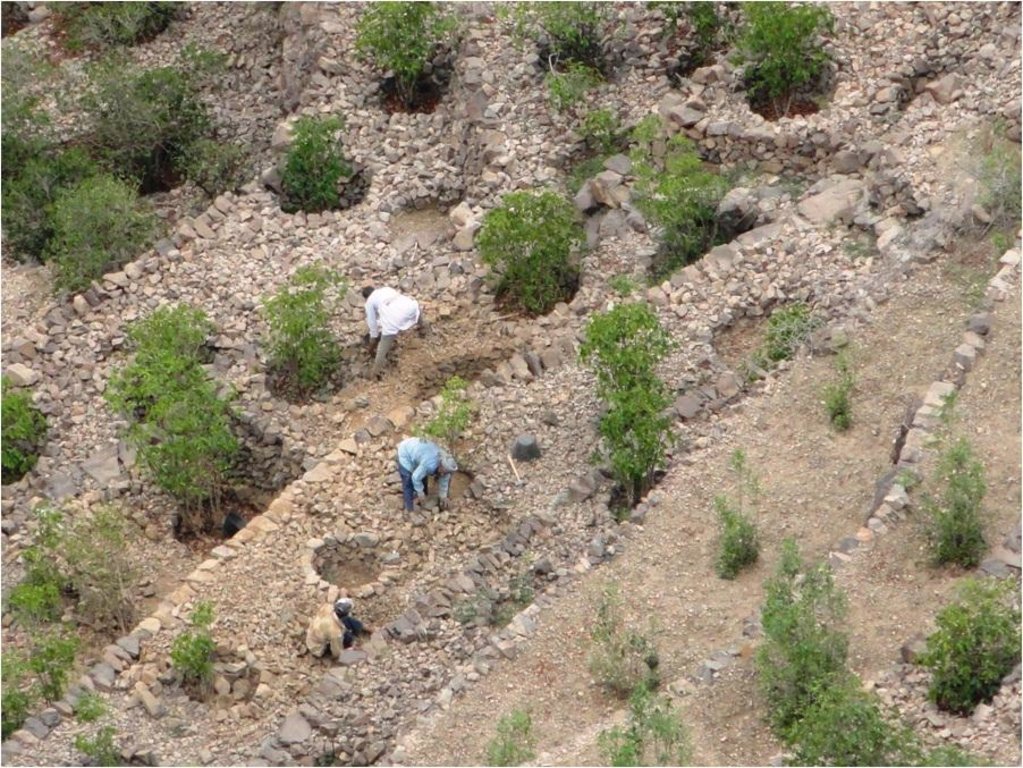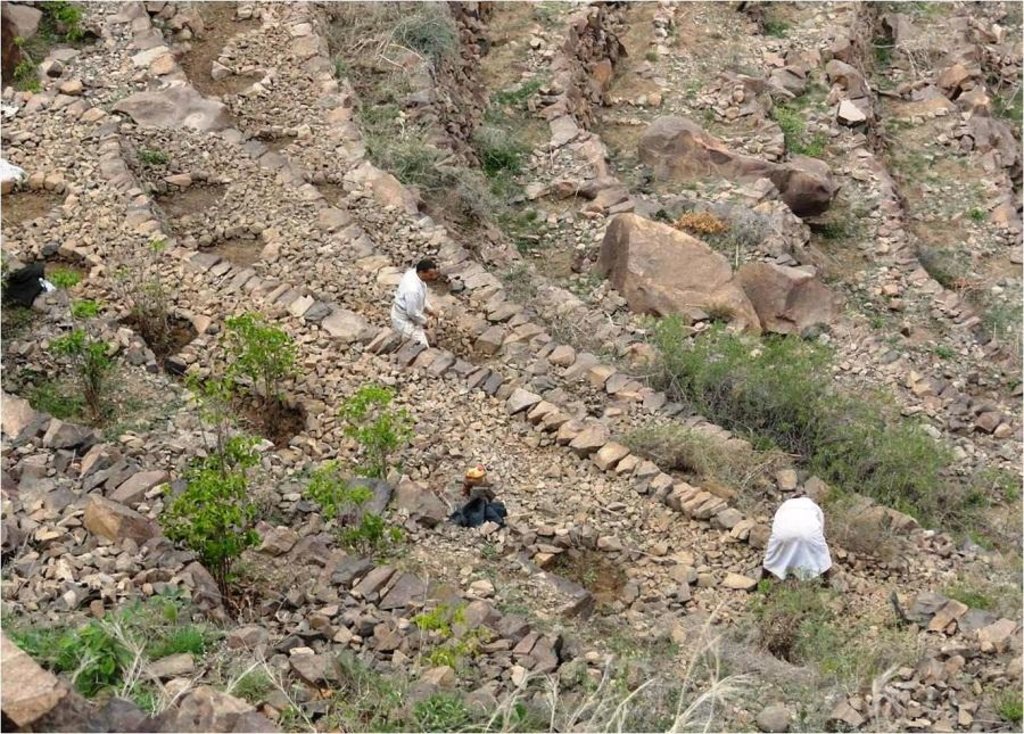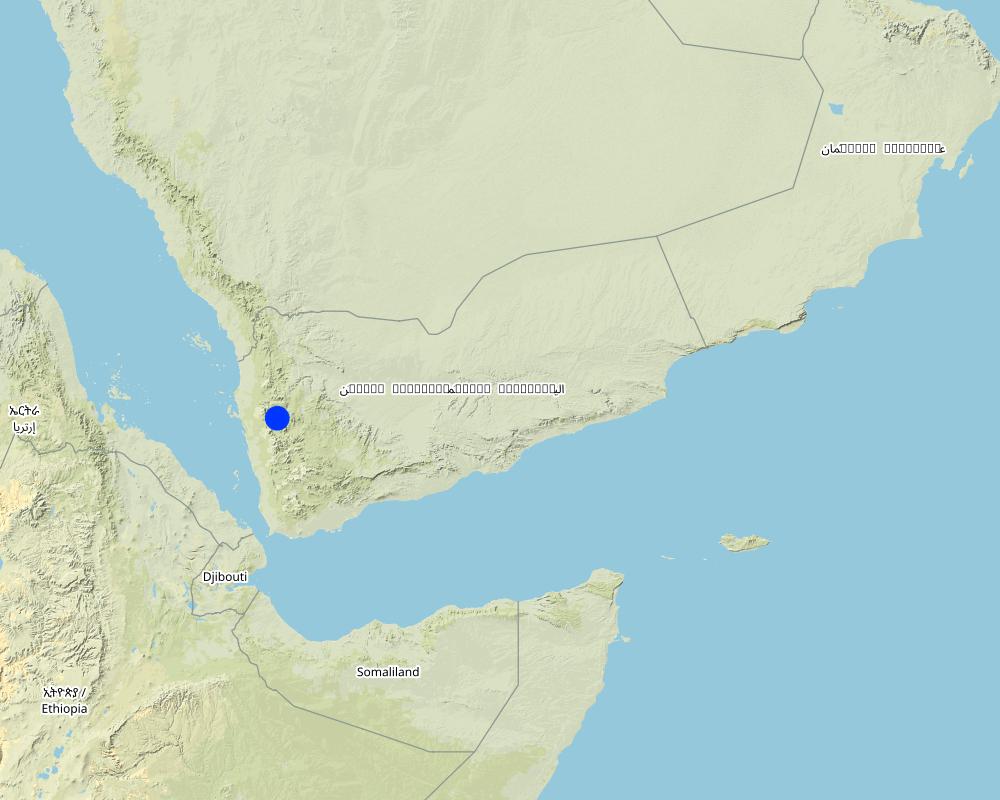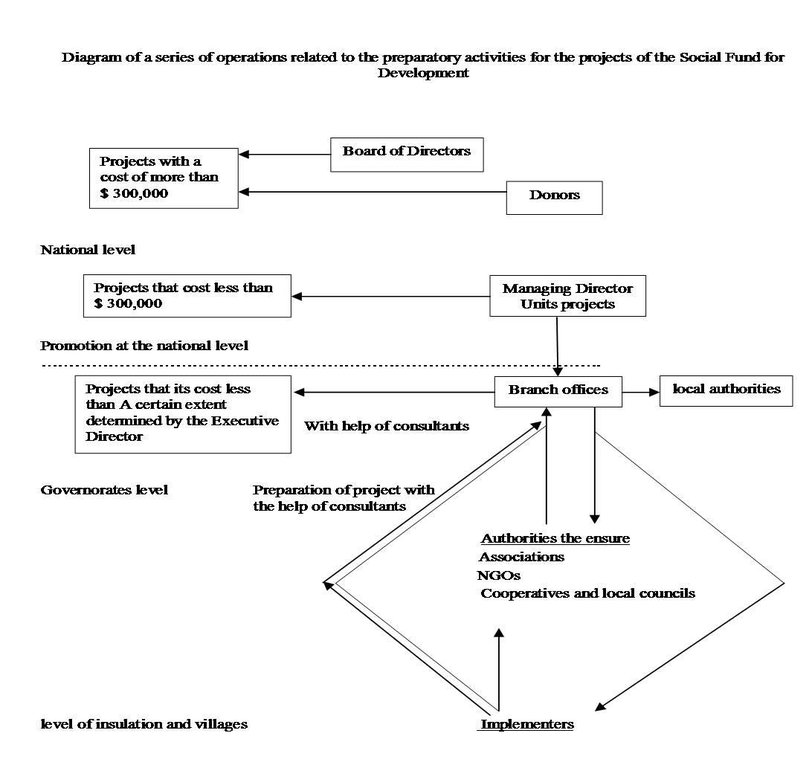Building and rehabilitation of agricultural terraces. [اليمن]
- تاريخ الإنشاء:
- تحديث:
- جامع المعلومات: ahmed algalal
- المحرر: –
- المراجعون: Fabian Ottiger, Joana Eichenberger
بناء وإعادة تأهيل المدرجات الزراعية
approaches_2586 - اليمن
عرض الأقسام
توسيع الكل طي الكل1. معلومات عامة
1.2 تفاصيل الاتصال بالأشخاص الرئيسيين لمصدر المعلومات والمؤسسات المعنية بتقييم وتوثيق النهج
متخصص في الإدارة المستدامة للأراضي:
Ibrahem Abdullah
00967777595480
Agricultural Research and Extension Authority, AREA
اليمن
اسم المؤسسة (المؤسسات) التي سهلت توثيق/تقييم النهج (إذا كان ذلك على صلة)
Agricultural Research and Extension Authority (AREA) - اليمن1.3 الشروط المتعلقة باستخدام البيانات الموثقة من خلال WOCAT
متى تم تجميع البيانات (ميدانيا)؟:
20/02/2013
يوافق جامع المعلومات والشخص (لاشخاص) الرئيسي لمصدر المعلومات على الشروط المتعلقة باستخدام البيانات الموثقة من خلال WOCAT:
نعم
1.4 المراجع الخاصة باستبيان(استبيانات) تقنيات الإدارة المستدامة للأراضي
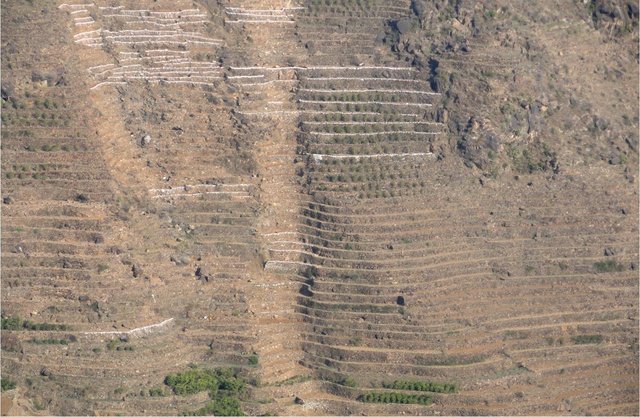
Bench terraces covered with small stones [اليمن]
Building terraces in steep areas for the purpose of reducing the slope, water harvesting and soil moisture conservation.
- جامع المعلومات: ahmed algalal
2. وصف نهج الإدارة المستدامة للأراضي
2.1 وصف موجز للنهج
Pay incentives for farmers rehabilitate degraded terraces in order to face the crisis of increasing food prices.
2.2 وصف تفصيلي للنهج
وصف تفصيلي للنهج:
Aims / objectives: The main objective is to rehabilitate the degraded terraces and to protect them from erosion through the payment of incentives. Conservation of land resources should be achieved through cooperation between the land users applying local knowledge and traditional practices for soil conservation. Through this, the livelihoods of land users are improved and it helps them to continue their farming operations which helps to alleviate poverty. Through the Social Development Fund the state aims to improve community development through a comprehensive concept and to address the crisis of rising food prices. Through this fund land users receive support for their physical work. The rehabilitated terraces will later help them to improve their agricultural income The project interferes in the region through the involvement of land users (from bottom to top). To help them solve their problems, a study of the region’s problems using Participatory Rapid Rural Appraisal (PRA) and a Participatory Learning Approach (PLA) was conducted. With the participation of the community problems and constraints were identified and appropriate solutions developed, as well as priorities identified for intervention. An inventory of households was done by a dedicated team to determine the costs and the appropriate methods for the implementation process and the mechanisms used for the implementation. Furthermore awareness rising was carried out. After completion of the technical study and determination of the costs, the areas where the activities should be implemented were assigned to a specialist. After the technical study is finished and the cost of implementing for the targeted area is determined and allocated. Then Social Fund for Development office SFD appoints specialized person to follow up the implemented activities ,which usually carry out by the land users and as long as they finished the implemented activities they should receives their money (this the explanation of SDF and receivables). It should be noted that there is a lack of funding all the degraded areas, so that the SFD select only the degraded areas which are their owner unable to rehabilitate them.
2.3 صور عن النهج
2.5 البلد/المنطقة/المواقع التي تم تطبيق النهج فيها
البلد:
اليمن
المنطقة/الولاية/المحافظة:
Sana'a governorate
مزيد من التفاصيل حول الموقع:
Bani Ismail- Manakha District
Map
×2.6 تواريخ بدء وإنهاء تنفيذ النهج
أشر إلى سنة البدء:
2010
سنة الإنهاء (إذا لم يعد النهج مطبقًا):
2011
2.7 نوع النهج
- قائم على مشروع/برنامج
2.8 الغايات/الأهداف الرئيسية للنهج
The Approach focused mainly on SLM with other activities (Facing increasing food prices i.e. Money against work.)
Rebuilding the degraded terraces and protect them from degradation
The SLM Approach addressed the following problems: Lack of money for implementing terraces, poverty.
2.9 الظروف التي تمكن أو تعيق تنفيذ التقنية/التقنيات المطبقة بموجب النهج
توفر/الوصول إلى الموارد والخدمات المالية
- معيق
Not enough finances available.
Treatment through the SLM Approach: Supporting land users with funds (money against work).
الإطار القانوني (حيازة الأراضي، وحقوق استخدام الأراضي والمياه)
- تمكين/تمكيني
The existing land ownership, land use rights / water rights greatly helped the approach implementation: Initiate all land users in rehabilitating the degraded terraces without any conflict as long as they believe of work together and with spirit team work.
3. المشاركة وأدوار الأطراف المعنية
3.1 أصحاب المصلحة المعنيون بالنهج وأدوارهم
- مستخدمو الأراضي المحليون/المجتمعات المحلية
Both gender men and women. Men have more experience and more power for work than the women. Women carried out the weeding in the field in addition to food preparation at home.
- متخصصون في الإدارة المستدامة للأراضي / مستشارون زراعيون
- الحكومة الوطنية (المخططون، صانعو القرار)
3.2 انخراط مستخدمي الأراضي المحليين/المجتمعات المحلية في المراحل المختلفة للنهج
| انخراط مستخدمي الأراضي المحليين/المجتمعات المحلية | حدد من شارك وصف الأنشطة | |
|---|---|---|
| المبادرة/التحفيز | تفاعلي | Identified the problems, suggested solutions and determined the priority for implementation – local community |
| التخطيط | تفاعلي | |
| التنفيذ | تفاعلي | Land users carried out all the implementation under the supervision of supporting donors. |
| الرصد/التقييم | غير موجود | |
| Research | غير موجود |
3.3 مخطط التدفق (إذا كان متاحًا)
الوصف:
Diagram of a series of operations related to the preparatory activities for projects the Social Fund for Development
المؤلف:
(Sana'a)
3.4 اتخاذ القرار بشأن اختيار تقنية/تقنيات الإدارة المستدامة للأراضي
حدد من الذي قرر اختيار التقنية/التقنيات التي سيتم تنفيذها:
- مستخدمو الأراضي وحدهم (المبادرة الذاتية)
اشرح:
It is a traditional technology and still exist but it needs maintenance.
Decisions on the method of implementing the SLM Technology were made by mainly by land users supported by SLM specialists. The approach for implementation can be done by consulting and discussing it with the land users.
4. الدعم الفني وبناء القدرات وإدارة المعرفة
4.1 بناء القدرات/التدريب
هل تم تقديم التدريب لمستخدمي الأراضي / الأطراف المعنيين الآخرين؟:
نعم
حدد من تم تدريبه:
- مستخدمو الأراضي
شكل التدريب:
- Meetings
المواضيع المغطاة:
Awareness campaign to increase the importance on preserving land and conserving it to avoid any damages as a result of degradation as then it becomes difficult to repair it by the land users. Finally, this situation will lead to land abandonment and emigration.
4.2 خدمة استشارية
هل يملك مستخدمو الأراضي وصولا إلى خدمة استشارية؟:
نعم
- Meetings
4.3 تعزيز المؤسسات (التطوير التنظيمي)
هل تم إنشاء أو تعزيز مؤسسات من خلال هذا النهج؟:
- لا
4.4 الرصد والتقييم
هل يشكل الرصد والتقييم جزءا من النهج؟:
نعم
التعليقات:
technical aspects were regular monitored by project staff through measurements; indicators: None
socio-cultural aspects were regular monitored by project staff, land users through measurements; indicators: None
economic / production aspects were ad hoc monitored by project staff through observations; indicators: None
no. of land users involved aspects were regular monitored by project staff through measurements; indicators: None
bio-physical aspects were ad hoc monitored by project staff through observations; indicators: None
management of Approach aspects were regular monitored by project staff, land users through observations; indicators: None
There were few changes in the Approach as a result of monitoring and evaluation: Increase the target area
There were no changes in the Technology as a result of monitoring and evaluation: None
4.5 البحوث
هل كانت البحوث جزءًا من النهج؟:
كلا
5. التمويل والدعم المادي الخارجي
5.1 الميزانية السنوية لمكون الإدارة المستدامة للأراضي في النهج المذكور
إذا لم تكن الميزانية السنوية الدقيقة معروفة، قم بالإشارة إلى نطاقها:
- 100,000-10,000
التعليقات (على سبيل المثال المصادر الرئيسية للتمويل/الجهات المانحة الرئيسية):
Approach costs were met by the following donors: government (Labour (Money against work).): 100.0%
5.2 الدعم المالي/المادي المقدم لمستخدمي الأراضي
هل حصل مستخدمو الأراضي على دعم مالي/ مادي لتنفيذ التقنية/ التقنيات؟:
نعم
إذا كانت الإجابة بنعم، حدد نوع (أنواع) الدعم والشروط والمزودين:
Money against work
5.3 إعانات لمدخلات محددة (بما في ذلك العمالة)
إذا كان العمل من قبل مستخدمي الأراضي مدخلاً جوهريًا، فهل كان:
- مدفوع نقدا
التعليقات:
Conducting works by contracting
5.4 الائتمان
هل تم توفير ائتمان في إطار نهج أنشطة الإدارة المستدامة للأراضي؟:
كلا
6. تحليل الأثر والتصريحات الختامية
6.1 آثار النهج
هل ساعد النهج مستخدمي الأراضي على تنفيذ وصيانة تقنيات الإدارة المستدامة للأراضي؟:
- لا
- نعم، قليلا
- نعم، باعتدال
- نعم، إلى حد كبير
Periodical maintenance is very important for terraces to protect them from degradation and conserving soil moisture as well.
Did other land users / projects adopt the Approach?
- لا
- نعم، قليلا
- نعم، باعتدال
- نعم، إلى حد كبير
Did the Approach lead to improved livelihoods / human well-being?
- لا
- نعم، قليلا
- نعم، باعتدال
- نعم، إلى حد كبير
Did the Approach help to alleviate poverty?
- لا
- نعم، قليلا
- نعم، باعتدال
- نعم، إلى حد كبير
Rehabilitating degraded terraces bringing them back into production. Consequently alleviation of poverty.
6.2 المحفز الرئيسي لقيام مستخدمي الأراضي بتنفيذ الإدارة المستدامة للأراضي
- زيادة الإنتاج
Increase the amount of production
- الوعي البيئي
- Decrease the emigration.
Provide livelihoods (re-construction of terraces)
- Protect the land from erosion.
6.3 استدامة أنشطة النهج
هل يمكن لمستخدمي الأراضي المحافظة على استدامة ما تم تنفيذه من خلال النهج (بدون دعم خارجي)؟:
- غير مؤكد
إذا كان الجواب لا أو غير متأكد، حدد ذلك وعلق عليه:
Lack of financial resources
6.4 نقاط قوة/مزايا النهج
| نقاط القوة/ المزايا/ الفرص من وجهة نظر مستخدمي الأراضي |
|---|
| Use the available resources to rehabilitation of terraces. It means:'Rehabilitation of terraces should be depend on the existing materials in the region such as stones or water, and labour). |
| نقاط القوة/ المزايا/ الفرص من وجهة نظر جامع المعلومات أو غيره من الاشخاص الرئيسيين لمصدر المعلومات |
|---|
| Work together in groups strengthens the social relationship between land users, which leads to increased initiative or motivation between them. Like this they are prepared to face any damage that may occur as a result to natural crisis such as climate change or drought. (How to sustain/ enhance this strength: Legislation should be implemented because it will lead to enhance the links between the local community and raise the work together in every business. it mean: 'It should be implemented and adopted ) |
6.5 نقاط الضعف/ العيوب في المنهج وطرق التغلب عليها
| نقاط الضعف/ المساوىء/ المخاطر من وجهة نظر جامع المعلومات أو غيره من الاشخاص الرئيسيين لمصدر المعلومات | كيف يمكن التغلب عليها؟ |
|---|---|
|
There are some regions which are still degraded and that have not been yet rehabilitated due to lack of financial resources |
Supporting farmers to rehabilitate the degraded land especially the terraces to achieve sustainable development and stop migration from rural areas to big cities. This can be done and to through alleviating poverty and at the same time preserving the limited land resources and utilized them in a sustainable way. |
7. المراجع والروابط
7.1 طرق جمع/مصادر المعلومات
- زيارات ميدانية، مسوحات ميدانية
- مقابلات مع مستخدمي الأراضي
7.2 المراجع للمنشورات المتاحة
العنوان، المؤلف، السنة، النظام القياسي الدولي لترقيم الكتب ISBN:
Technical study for construction and reclamation for terraces in some villages, Bani Ismail's uzlah, Manakhah district. Mid-monthly reports for implanting terraces construction in Bani Ismail's uzlah, Manakhah district.
متاح من أين؟كم التكلفة؟:
- Social Fund for Development, Sana'a 97671449672- Social Fund for Development, Sana'a 97671449672
العنوان، المؤلف، السنة، النظام القياسي الدولي لترقيم الكتب ISBN:
Mid-monthly reports for implanting terraces construction in Bani Ismail's uzlah, Manakhah district.
متاح من أين؟كم التكلفة؟:
Social Fund for Development, Sana'a 97671449672
الروابط والوحدات المواضيعية
توسيع الكل طي الكلالروابط

Bench terraces covered with small stones [اليمن]
Building terraces in steep areas for the purpose of reducing the slope, water harvesting and soil moisture conservation.
- جامع المعلومات: ahmed algalal
الوحدات المواضيعية
لا يوجد وحدات مواضيعية


